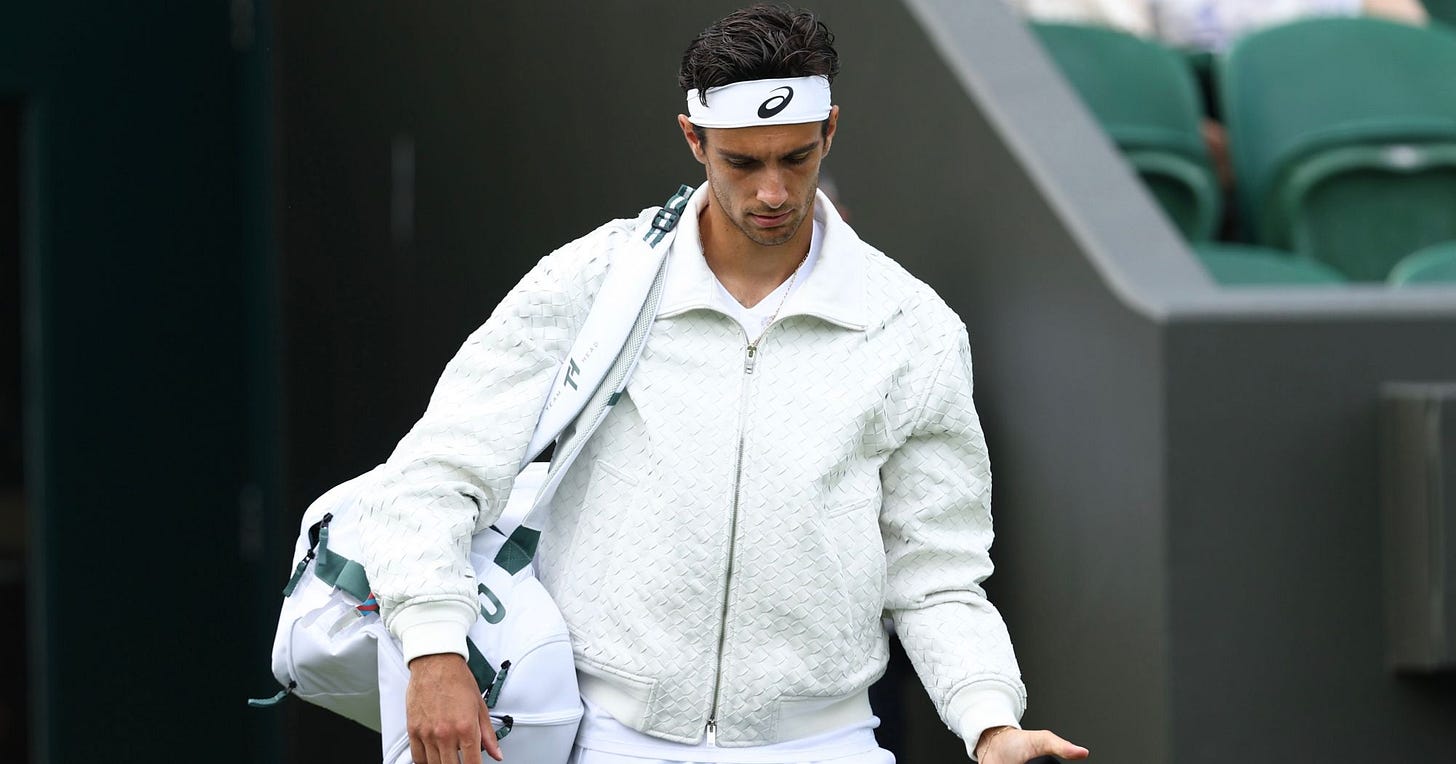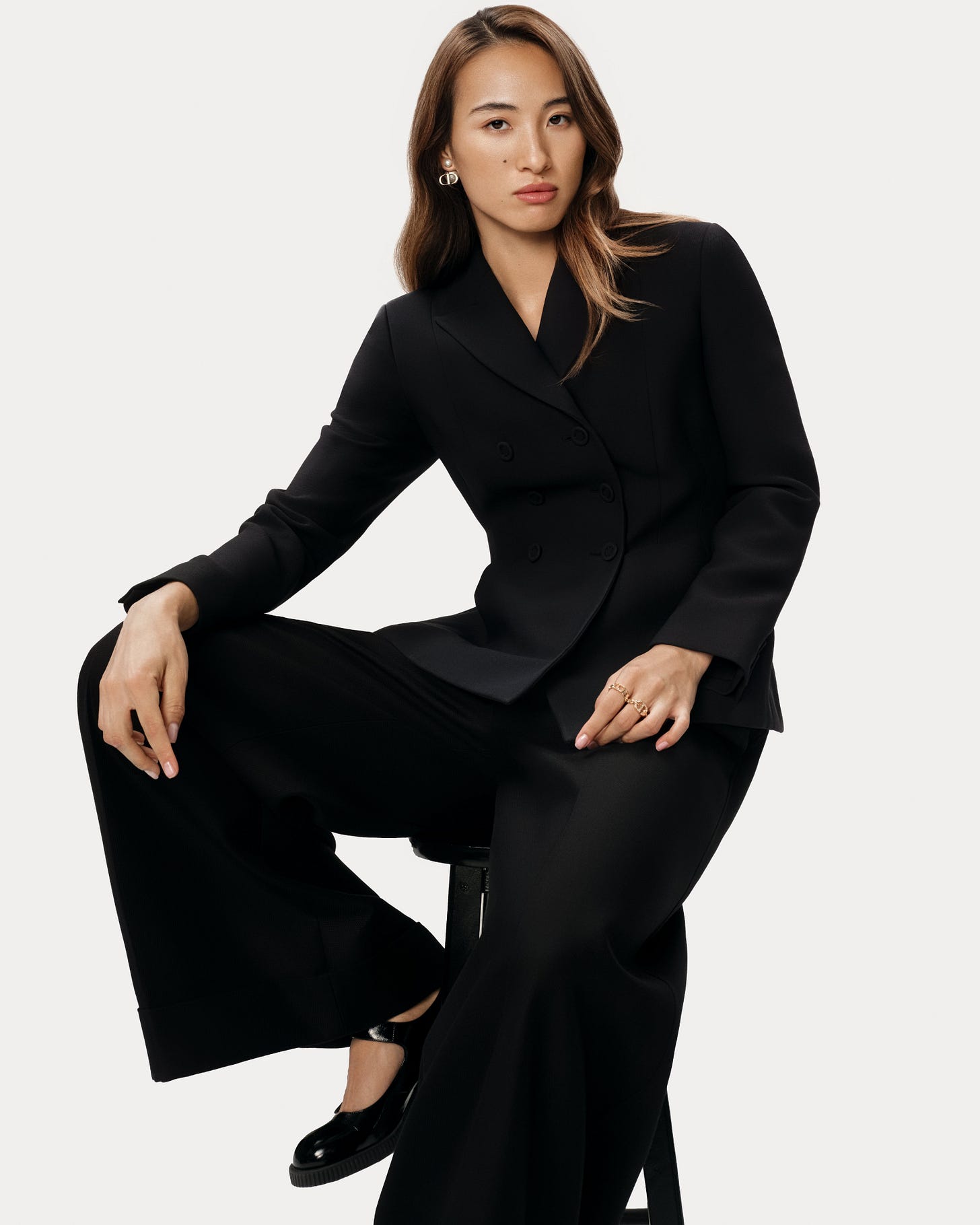Tennis, Fashion & Jonathan Anderson
As fashion’s relationship with tennis matures, a quiet entry may be the most significant.
Welcome to the FRM CREATIVE Substack, a weekly long-form version of our conversations in the studio on all things entertainment, which for us is music, sport, film, and television, and a dash of fashion.
Wimbledon has long been a stage for more than just championship tennis. The sport’s choreography of tradition and elegance has made it fertile ground for fashion houses seeking cultural resonance.
Ralph Lauren, with its perennial All England Club partnership, remains synonymous with Wimbledon whites, while Lacoste’s legacy is stitched into the sport’s very DNA.
But as Ralph Lauren strategically pivots toward paddle, a sport with fast-growing social capital, and Lacoste flirts with Gen-Z relevance, new players are emerging.
Bottega Veneta’s presence this year, via Lorenzo Musetti, their latest ambassador wearing their iconic woven leather jacket and the box seating of their Creative Director, Louise Trotter (former Lacoste Creative Director), showed the house staking its claim on tennis’s cultural moment.
And yet, the most consequential development may be one that slipped by, untelegraphed. Jonathan Anderson, newly installed as Artistic Director of Dior across both men’s and women’s collections, could be quietly laying the groundwork for a deeper, more strategic relationship between luxury fashion and tennis.
The face of this potential ambition? Rising Chinese star, 2024 Olympic gold medalist, and Global Dior Ambassador Quinwen Zheng. If her on-court game is assertive, electric yet gracious, her off-court style is catching up fast. She’s not merely flirting with fashion; she’s front and center.
Her appearance at the Balenciaga Couture show last June, sitting beside Anna Wintour, underscored the industry’s growing attention. Her soft-launch as a Global Dior ambassador, carefully choreographed during the WTA Finals: Riyadh Annual Portrait in October 2024, coupled with Anderson’s recent appointment, could suggest something more deliberate.
Game. Set. Runway.
Tennis has always drawn fashion’s eye, photogenic, elite, and built on performance narratives that translate well to storytelling. But while many brands continue to dip into tennis for seasonal campaigns around the Grand Slams, Anderson’s vision could be longer, deeper, and more architected.
And it didn’t start at Dior.
His relationship to tennis has been evolving across disciplines. For Luca Guadagnino’s Challengers - the taut, stylish tennis love triangle starring Zendaya and Josh O’Connor - Anderson served as costume designer. His approach was less functional than psychological: polos became emotional cues; tennis whites became loaded symbols. The wardrobe heightened not just the athleticism, but the interior drama of the characters.
And under his creative direction at Loewe, Anderson collaborated with Swiss performance brand ON, co-founded by Roger Federer, to produce a line of minimalist technical wear that quietly disrupted the performance-luxury category.
These weren’t sneakers for weekend joggers; they were lifestyle objects. The tie to Federer, a player long synonymous with elegance and understatement, gave the collaboration a kind of quiet fluency that Anderson could now channel into his work at Dior.
Zheng, who embodies both grace and grit, is an ideal ambassador for this evolving vision of athletic femininity. She’s not a muse in the traditional sense, more co-creator than mannequin, and Dior’s alignment with her allows the house to explore the new codes of performance dressing in a post-streetwear world.
Off-court: Fashion and Hospitality.
The challenge facing fashion’s current romance with tennis, like all cultural moments, is sustainability. The smart players are already thinking beyond headlines, into infrastructure. This is where Dior, under Anderson, has a unique advantage.
Dior has steadily extended its reach into luxury hospitality, with a focus on wellness: Dior-branded spas at The Lana in Dubai, Cheval Blanc Paris, Hotel du Cap-Eden-Roc, and The Beverly Hills Hotel, among others. These aren’t just amenities, they’re lifestyle blueprints. And with luxury hotels increasingly building tennis, paddle, and pickleball courts into their property offerings not as afterthoughts but as experiential luxury, there’s a credible opening for Dior to participate, leveraging their ambassador who’s also a Top 8 WTA player.
Imagine a Dior-designed tennis court. Custom coaching kits, spa-meets-locker-room hybrids, bespoke courtside events, training, and nutrient plans made collaboratively with Quinwen. It wouldn’t have to be flashy, but elegantly embedded into a hospitality experience. A soft-power expansion of what sport can mean in a luxury context.
Building Legacy
Tennis is one of the few sports where men and women compete for close to equal pay, equal screen time, and equally feverish fan devotion. It isn’t “men’s” or “women’s”, it’s simply tennis. That parity makes it uniquely attractive for brands looking to engage with modern, balanced storytelling.
Anderson’s arrival at Dior positions the house to play not just on the edges of tennis, but in its future architecture. He’s not merely dressing athletes. He’s building a language around their presence.
Zheng’s ambassadorship, Challengers’ psychological wardrobe, the Loewe x ON collaboration - these weren’t side projects. They were sketches for something larger. Something we want to see taking full form at Dior.
Because the game isn’t just about what’s worn, it’s about what’s built.
Thank you for reading our opinions and predictions on the industries we think, f(or)rm, and execute creative projects for.







